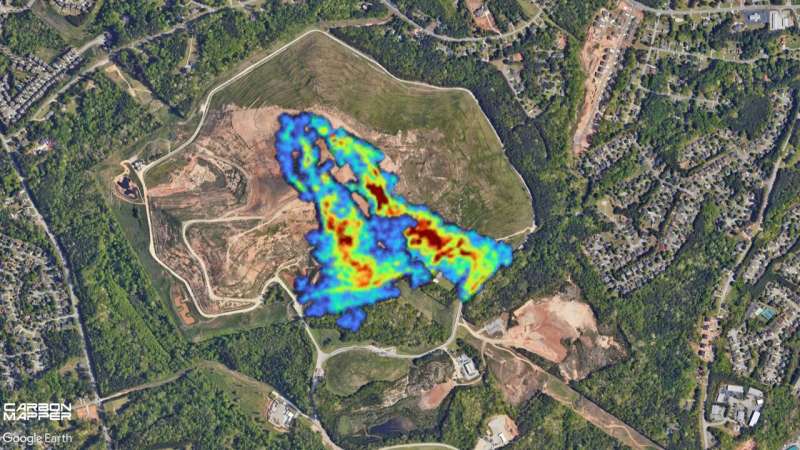This article has been reviewed according to Science X's editorial process and policies. Editors have highlighted the following attributes while ensuring the content's credibility:
fact-checked
peer-reviewed publication
proofread
Study finds landfill point source emissions have an outsized impact and present opportunity to tackle US waste methane

A new study, led by Carbon Mapper scientists alongside researchers from NASA Jet Propulsion Laboratory, Arizona State University, University of Arizona, Scientific Aviation, and the U.S. Environmental Protection Agency, provides the largest comprehensive assessment of hundreds of U.S. landfills using direct observations through airborne surveys.
The study, published in the journal Science, reveals the outsized impact of landfill point source emissions, which are responsible for a disproportionately large share of pollution from this important sector. It also sheds light on potential gaps in traditional model-based emission accounting methods that may benefit from sustained direct measurement using emerging surface-, air-, and space-based monitoring technologies.
"Addressing these high methane sources and mitigating persistent landfill emissions offers a strong potential for climate benefit," said Dr. Dan Cusworth, Carbon Mapper Program Scientist and lead author on the paper.
"The ability to precisely identify leaks is an efficient way to make quick progress on methane reduction at landfills, which could be critical for slowing global warming."
Landfills are considered the third largest source of human-caused methane emissions in the U.S., responsible for 14.3% of methane in 2021 and emitting the equivalent to the greenhouse gas (GHG) emissions from nearly 23.1 million gasoline-powered passenger vehicles driven for one year, according to the EPA.
Despite the climate impact of landfills, societal understanding of these emissions is largely limited to model-based estimates, and the sector remains under-addressed compared to other big methane sources like oil and gas. Traditional surface-based surveys with handheld methane sensors provide an incomplete picture of emissions. This is due to factors like limited access to many sections of active landfills as well as logistical and personnel safety reasons.
To help fill these gaps, Carbon Mapper and research partners used advanced aircraft to conduct the largest direct measurement-based survey of active municipal solid waste landfills to date from 2018 through 2022. This included aerial surveys, led by Carbon Mapper and Scientific Aviation, of over 200 active U.S. landfills that participate in the U.S. Greenhouse Gas Reporting Program (20% of approximately 1,200 reported open landfills). Surveys led by Carbon Mapper utilized partner aircraft—including NASA JPL's AVIRIS-NG and Arizona State University's Global Airborne Observatory with the Center for Global Discovery and Conservation Science.
Key findings
Evaluating this large data set yielded insights that site owners and operators, policymakers, regulators, and civil society can use to better assess and act on landfill emissions.
- Landfill point source emissions have an outsized methane impact: 52% of surveyed landfills had observable point source emissions. This far exceeds the 0.2% to 1% detection rate observed for super-emitters from surveyed oil and gas infrastructure in California and the Permian Basin.
- Landfill point source emissions are generally more persistent compared to their counterparts in oil and gas production: For those landfills with observed emissions, 60% had emissions that persisted over months or years. These persistent emissions totaled 87% of all quantified emissions in the study. Comparatively, the majority of methane super-emitters in the oil and gas sector are related to irregular, short-duration events.
- There are significant gaps in landfill leak detection and quantification protocols: Current walking surveys with hand-held sensors are ineffective in completely sampling the landfill surface and may miss high point source activity that can dominate the facility's emissions while remaining undetected for extended periods. Advanced monitoring strategies, such as remote sensing from satellites, aircraft and drones, can provide a more accurate picture of landfill methane emissions. When combined with improved ground-based measurements, remote sensing can provide consistent, comprehensive measurements to better inform models, guide mitigation efforts and verify emission reductions.
- A robust dataset of quantified emissions at U.S. landfills finds little agreement with national reporting frameworks: A misalignment between observed and reported emissions indicates that current methods used to report facility emissions, such as the EPA's Greenhouse Gas Reporting Program (GHGRP), are missing or misrepresenting large sources of methane. On average, aerial emission rates were 1.4 times higher than GHGRP. This presents a significant difference between observed and reported emissions, supported by the largest airborne or ground-based survey of U.S. landfills to date.
Looking forward, this study reveals the need for a comprehensive monitoring strategy to measure, quantify and act on methane emissions at landfills more effectively. Resources like the Carbon Mapper Coalition satellite program can offer efficient solutions for measurement challenges. The coalition's first Tanager satellite, which is launching in 2024 as part of a public-private partnership between Carbon Mapper, Planet Labs PBC, NASA JPL and others, is uniquely designed and optimized to detect methane at landfills.
Carbon Mapper is also conducting a multi-year initiative to assess thousands of high-emitting solid waste sites globally, using remote sensing technologies to establish a methane emissions baseline for managed landfills and unmanaged dumps. This includes U.S. landfill aerial campaigns planned for 2024.
Carbon Mapper's methane data is publicly available on its portal to maximize the availability of emissions data for a wide range of operators across many jurisdictions, including major waste management companies and local city and county governments. This helps empower them to mitigate emissions and make informed decisions that maximize methane capture. The data is also made available for policymakers, regulators, community groups and others to support science-based decision making.
More information: Daniel H. Cusworth, Quantifying methane emissions from United States landfills, Science (2024). DOI: 10.1126/science.adi7735. www.science.org/doi/10.1126/science.adi7735
Journal information: Science
Provided by Carbon Mapper




















